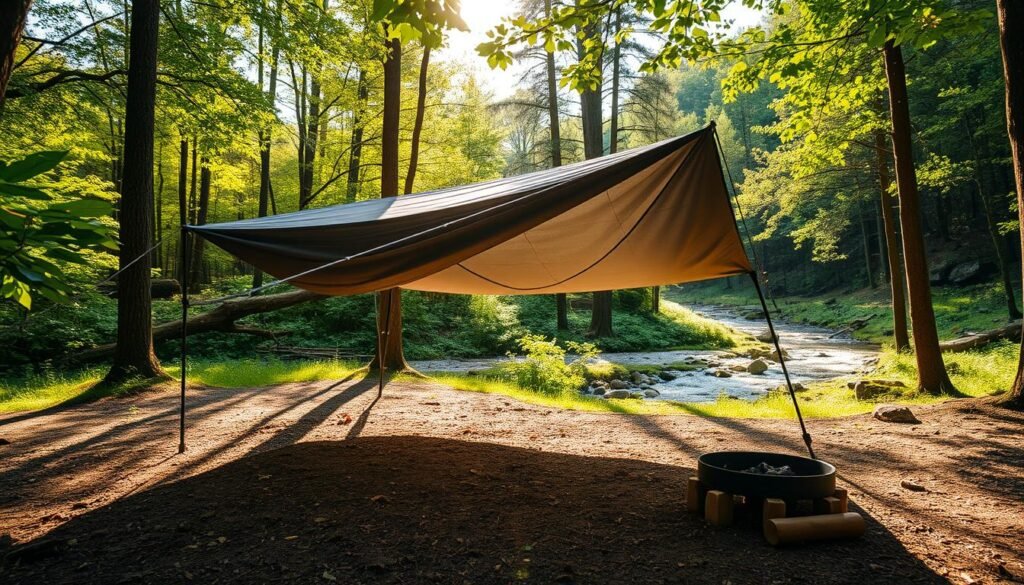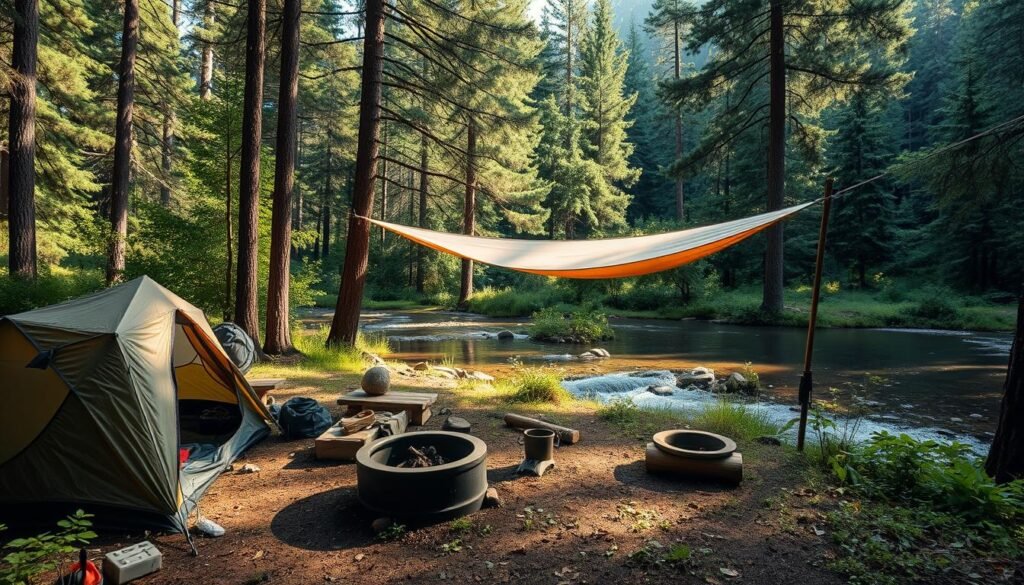Are you ready to elevate your outdoor adventures? What makes a campsite truly unforgettable?
As an outdoor enthusiast, I’ve learned that setting up the perfect campsite is crucial for a comfortable and enjoyable experience. In this article, I’ll share my top tips for creating an ideal outdoor living space. We’ll cover essential aspects like site selection, shelter, and safety.
When it comes to camping gear, having the right essentials can make all the difference. From choosing the perfect location to setting up a safe and cozy shelter, I’ll guide you through the process. This will help you create an unforgettable outdoor experience.
The Art of Choosing the Perfect Campsite
Choosing the right campsite is key to a great camping trip. It’s all about the little details that make a big difference. I’ve learned that the best spot can set the tone for your adventure.
Deciding between a forest and an open field is important. Forests offer natural shelter and you can use logs as seats. But, they might have more bugs and animals.
Open fields give you a clear view and lots of sunlight. Yet, they can be tough when the weather gets bad.
Mountain vs. Valley Positioning
Choosing between mountains and valleys depends on what you like. Mountains have amazing views and cooler weather. But, they can be hard to get to.
Valleys are safer and have water nearby. But, they might flood. Good tent equipment is essential for a comfy stay in either place.
Being close to water is both good and bad. It’s great for drinking and washing up. But, it can also attract animals and cause floods. Keeping your campsite organized is crucial for a safe trip.
Location Considerations for Your Camp Setup
Finding the perfect spot for your camp is more than just a pretty view. It’s about safety and comfort. You need to think about the location and any dangers it might have.
Dead Trees and Falling Branch Risks
Look out for dead trees and falling branches in the terrain. Check the trees around you for any signs of decay. A falling branch can be very dangerous, so stay away from weak trees.
Flash flooding is another big risk. Watch your surroundings and don’t camp in low areas or near dry riverbeds. These spots can become dangerous fast during rain. Always check local rules to make sure your spot is safe for camping.
To make your camping better, think about the outdoor comforts you can bring. Things like comfy sleeping arrangements and the right campsite accessories can really improve your experience.
Water Proximity: Weighing the Benefits and Risks
Reflecting on my camping trips, being near water has been both good and bad. Having clean water nearby makes tasks like cooking and washing easier. It’s a big plus for camping gear and outdoor living.
But, being too close to water can be risky. Risks include rising water and more bugs. It’s key to find a balance and camp safely away from the water.
Camping near water can lead to rising water levels. This might happen due to rain or dam releases. Keeping your tent at least 200 feet from the water helps avoid flooding.
Insect Populations Near Water
Water attracts many insects, some of which can bother you. Camping far from water reduces bug exposure. Using the right camp cooking tools and taking steps to prevent bugs can also help.
In summary, camping near water has its perks but also risks. Being aware and taking precautions ensures a safe and enjoyable outdoor experience.
Creating the Optimal Camp Layout
Creating a great camp layout is key for both fun and comfort. A well-planned campsite makes your trip better, safer, and more comfortable.
Creating Separation Between Sleeping and Food Areas
It’s important to keep sleeping areas away from food and cooking. This keeps things clean and safe from wild animals. I always place my tent far from where I cook.
When setting up your tent, pick a flat spot and clear it of rocks or debris. A good tent equipment list includes a ground tarp to keep your tent dry and comfy.

Having places for everyone to hang out makes camping better. A well-organized campsite has spots for chatting and relaxing, like a campfire circle or picnic table. Adding camping furniture like chairs or a hammock makes your campsite more cozy and fun.
Designing your camp layout with care makes for a great outdoor adventure. The goal is to mix function with comfort, making your campsite welcoming and safe.
My Favorite Camp Setups for Different Weather Conditions
The outdoors can surprise us, and being ready for different weather is key. Over time, I’ve found a few camp setups that keep me comfy in various places.
Wind Blocking Techniques
When it’s windy, blocking the wind is vital to stay warm. I often use a tarp to make a windbreak. By angling the tarp, I can push the wind away and make a sheltered spot for my tent. Using a tarp this way greatly lessens the wind’s effect.
I also think about my campsite’s layout. By placing my tent and gear to avoid the wind, I can lessen its impact even more.
Heat Retention Strategies
In cold weather, keeping warm is essential for a good camping trip. I love using insulated sleeping bags and pads to stay toasty. I also wear warm clothes, like a hat and gloves, to keep from losing heat.
Another important part is cooking. With a portable camping stove, I can make hot meals and drinks. Cooking in a sheltered spot helps keep the heat in.
By using these strategies, I can enjoy camping in many weather conditions. Whether it’s windy or cold, the right setup and gear make camping comfy.
Mastering Tarp Setups for Enhanced Shelter
Learning to set up a tarp is key for any serious camper. A tarp adds great value to your camping gear, offering better shelter and protection. We’ll look at how to set up a tarp, like the A-frame and lean-to ways.
A-Frame Setup
The A-frame setup is a popular and effective method. It uses two sturdy objects, like trees, and angles the tarp to let water run off. This setup is great for a dry, wind-free area. You’ll need basic tent equipment like rope and stakes for it.

The lean-to setup is also versatile and works well in many camping spots. It leans the tarp against a solid object, like a big tree or rock, and secures it with stakes and rope. This is perfect for a dry, sheltered area in the woods. It also makes your outdoor living essentials better by giving you a comfy, dry place to relax.
Using a tarp well can really improve your camping. It not only adds more shelter but also keeps your tent cooler in summer by providing shade. Mastering tarp setups means a more comfortable and fun outdoor adventure.
Fire Safety and Management in Your Camp Setup
When you go outdoors, keeping fire safety in mind is key. A well-managed campfire can be a great outdoor comfort. It provides warmth and a way to cook meals with yourcamp cooking tools. But, it’s important to be careful to avoid accidents.
Safe Distances for Tents and Gear
It’s vital to keep your campfire away from tents and gear. I make sure mycampsite accessories, like tarps and sleeping bags, are far from the fire. Also, clear the area around the campfire of anything that can catch fire.
Another important thing is to think about the wind. Wind can spread embers and sparks, starting fires. Before starting a campfire, I check the wind direction. I pick a spot that reduces the chance of fire spreading.
Always have a bucket of water or a fire extinguisher ready when cooking with fire. This simple step can greatly help in case of an emergency. It keeps your outdoor adventure safe and fun.
Wildlife Considerations for Secure Camp Setups
To have a safe camp, knowing about local wildlife is key. Learning about their habits helps avoid dangerous meetings. When camping in bear country, following certain rules is very important.
Bear Country Protocols
Keeping your campsite clean is crucial in bear country. Store all food and scented items in bear-proof containers. Or hang them 10 feet up and 4 feet out from the trunk. Always check local bear safety rules before camping.

Bears are a big worry, but raccoons, rodents, and snakes can be threats too. Make sure your camping gear is safe and food is not left out. Using tent equipment that seals well can keep critters away.
By being careful and respecting nature, you can avoid bad wildlife encounters. It’s all about keeping your campsite safe and respecting the wild.
Essential Gear for Versatile Camp Setups
Spending years under the stars taught me the importance of the right gear. The right camping gear makes your outdoor adventure safer and more fun.
First Aid Essentials
A good first aid kit is crucial for any camping trip. It should have bandages, antiseptic wipes, pain relievers, and any personal meds. Always check your kit before you go to make sure everything is good to use.
Quality outdoor living essentials like a detailed first aid kit are worth it. They help you enjoy your trip without worrying about unexpected problems.
Even with modern GPS, having a compass and maps as backup is key. These campsite accessories can save your life if your main tools fail.
Reliable communication devices are also essential. This includes your phone and a two-way radio or satellite phone for areas without cell service. Having the right camping gear for staying in touch can be a lifesaver in emergencies.
By focusing on these key areas, you can have a safer and more enjoyable camping trip. Remember, the secret to a great camping trip is being well-prepared and having the right gear.
Packing Up: Lessons Learned from Years of Outdoor Adventures
Looking back on my outdoor adventures, I realize packing up is key. A tidy campsite is not just about pride. It’s also crucial for keeping nature untouched.
When it’s time to leave, I organize my gear carefully. I put things I use often in easy spots. This helps me find what I need quickly. I also check the site for any left-behind items, like stakes or trash, to leave it as I found it.
Being careful with our gear helps protect nature for others. Whether you’re experienced or new to camping, remember to pack up well. Share your tips for keeping campsites clean and organized.
